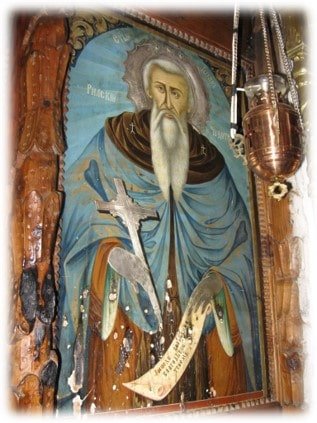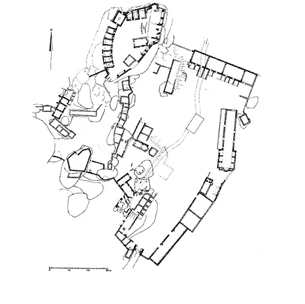Kellibara Monastery
per person
The Kellibara monastery is one of the most important foundations on Latmos (Latros), a monastic center in Caria, northeast of Miletos (Milet). The Latros monasteries are clustered on islands in the lake of Herakleia (Bafa Gölu) and on Mt. Latmos (modern Beşparmak).
The first monasteries were allegedly founded in the 7th century by monks who had fled from Sinai. Kellibara was one of these first foundations. Latros experienced its best phase in the first half of the 13th century, that is in the period after the Fourth Crusade and the establishment of a successor Greek State under the Lascarid dynasty. Charters from the 1220s relate to land disputes between Kellibara and Stylos. The Turkish conquest of the former Byzantine regions led to a decline of the monastic community in Kellibara which was reduced in only nine monks by the end of the 13th century. With an imperial decree dated at the same period, Kellibara was attached to St Demetrios, a foundation of the ruling dynasty (Palaiologoi) in Constantinople. Nothing can be found in the Greek Medieval sources after that date.
FORMAL ANALYSIS
The monastic complex consists of a larger eastern courtyard and a smaller western courtyard completely enclosed by rocks. To the north of the latter is an upper fort, to the south on a single rock a small refuge fort. The entire complex was circuited, and the courtyards were separated from each other by a wall. The wall was interrupted by rocks and in some points was formed by the outer walls of the buildings. Only the refuge fort, which was difficult to access, and the upper castle – with tower and battlements – were defensible.
The main gate was on the south and led into the first courtyard, where a creek was flowing. In the east side was a refectory and a small bad, whereas on the south were located the storage buildings.
In South-West were located two chapels and an apsis formed in a rock. The southern chapel included wall paintings of which we can identify the figures of Christ and Saint Arsenios. The frescoes are generally dated between the 11th and the 13th centuries.
In the second yard were located the cells of the monks, cisterns and another chapel from the 13th century.
EKATERINI MITSIOU
- Kellibara monastery © PHOT. https://www.tripadvisor.com.tr/LocationPhotoDirectLink-g780976-d16942478-i385579935-Yediler_Manastiri-Milas_Mugla_Province_Turkish_Aegean_Coast.html
- Kellibara monastery © PLAN. PECHLOW, https://www.thebyzantinelegacy.com/latmos
- The monastery from above © PHOT. https://gezicini.com/ yediler-manastiri/
- Ruins of the monastery © FOT. https://www.tripadvisor.com.tr/LocationPhotoDirectLink -g780976-d16942478-i385579935-Yediler_Manastiri-Milas_Mugla_ Province_Turkish_Aegean_Coast.html
- Monastery Yediler (Milas) © PHOT. The Byzantine Legacy: https://www.flickr.com/ photos/byzants/51089299267
- Monastery of Kellibara © FOT. https://www.tripadvisor.com.tr/LocationPhotoDirectLink-g780976 -d16942478-i385579935-Yediler_Manastiri-Milas_Mugla_Province_Turkish_ Aegean_Coast.html
Tour Location
Kellibara Monastery
| Other monuments and places to visit | Various monasteries and churches on Latmos |
| Natural Heritage | |
| Historical Recreations | |
| Festivals of Tourist Interest | |
| Fairs | |
| Tourist Office | No |
| Specialized Guides | No |
| Guided visits | No |
| Accommodations | No |
| Restaurants | |
| Craft | |
| Bibliography | |
| Videos | |
| Website |
| Monument or place to visit | Monastery of Kellibara/Yediler |
| Style | Remains of the 7th century and later (11th-13th centuries) |
| Type | Monastic architecture |
| Epoch | 7th century and later (11th-13th centuries) |
| State of conservation | Not very good condition |
| Degree of legal protection | |
| Mailing address | |
| Coordinates GPS | 37°29′52″ N 27°33′25″O |
| Property, dependency | |
| Possibility of visits by the general public or only specialists | Visits by the general public and specialists |
| Conservation needs | Yes |
| Visiting hours and conditions | Only guided tours |
| Ticket amount | |
| Research work in progress | |
| Accessibility | Not easy |
| Signaling if it is registered on the route | |
| Bibliography | A. Peschlow-Bindokat, Herakleia am Latmos. Stadt und Umgebung, Istanbul 2005 Th. Wiegand, Der Latmos, in: Milet III 1. Berlin 1913. H. Buchwald, Lascarid Architecture. Jahrbuch der Österreichischen Byzantinistik 28 (1979) 261-296. |
| Videos | Youtube Youtube |
| Information websites | kulturenvanteri.com |
| Location | Muğla, Milas, Turkey |



















